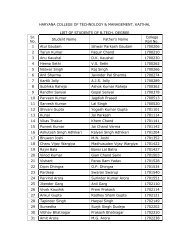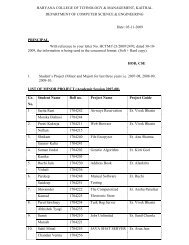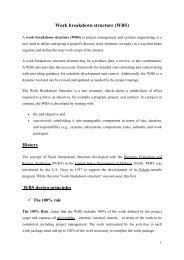Create successful ePaper yourself
Turn your PDF publications into a flip-book with our unique Google optimized e-Paper software.
LECTURE NOTES OF ADVANCED DATA STRUCTURE (MT-CSE 110)<br />
internal nodes may be joined or split. Because a range of child nodes is<br />
permitted, B‐trees do not need re‐balancing as frequently as other self‐<br />
balancing search trees, but may waste some space, since nodes are not entirely<br />
full. The lower and upper bounds on the number of child nodes are typically<br />
fixed for a particular implementation. For example, in a 2‐3 B‐tree (often simply<br />
referred to as a 2‐3 tree), each internal node may have only 2 or 3 child nodes.<br />
Each internal node of a B‐tree will contain a number of keys. Usually, the<br />
number of keys is chosen to vary between d and 2d. In practice, the keys take<br />
up the most space in a node. The factor of 2 will guarantee that nodes can be<br />
split or combined. If an internal node has 2d keys, then adding a key to that<br />
node can be accomplished by splitting the 2d key node into two d key nodes<br />
and adding the key to the parent node. Each split node has the required<br />
minimum number of keys. Similarly, if an internal node and its neighbor each<br />
have d keys, then a key may be deleted from the internal node by combining<br />
with its neighbor. Deleting the key would make the internal node have d − 1<br />
keys; joining the neighbor would add d keys plus one more key brought down<br />
from the neighbor's parent. The result is an entirely full node of 2d keys.<br />
The branches (or child nodes) from a node will be one more than the number of<br />
keys stored in the node. In a 2‐3 B‐tree, the internal nodes will store either one<br />
key (with two child nodes) or two keys (with three child nodes). A B‐tree is<br />
sometimes described with the parameters (d + 1) — (2d + 1) or simply with the<br />
highest branching order, (2d + 1).<br />
A B‐tree is kept balanced by requiring that all leaf nodes are at the same depth.<br />
This depth will increase slowly as elements are added to the tree, but an<br />
increase in the overall depth is infrequent, and results in all leaf nodes being<br />
one more node further away from the root.<br />
B‐trees have substantial advantages over alternative implementations when<br />
node access times far exceed access times within nodes. This usually occurs<br />
when the nodes are in secondary storage such as disk drives. By maximizing the<br />
number of child nodes within each internal node, the height of the tree<br />
decreases and the number of expensive node accesses is reduced. In addition,<br />
rebalancing the tree occurs less often. The maximum number of child nodes<br />
Prepared By :<br />
Er. Harvinder Singh<br />
Assist Prof., CSE, H.C.T.M (Kaithal) Page ‐ 211 ‐







